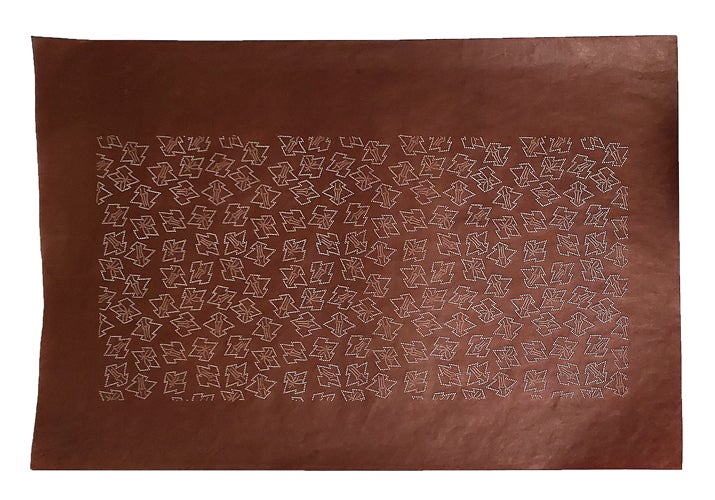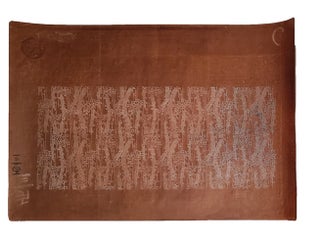Album of Original Kimono Stencil Plates.
KATAGAMI STENCIL DESIGNS. A Collection of Meiji Period Original Kimono Stencil Plates. With 20 stencil plates. Stencil paper was constructed from the bark of mulberry trees then treated with persimmon juice; the sheets measure ca. 220 x 400 mm., the largest measuring 350 x 450 mm. Each in individual mylar sleeves laid into an archival box. [Japan: Meiji Period, ca. 1868-1912].
A rare collection of late nineteenth and early twentieth-century Japanese stencils, created expressly for decoration of cotton, silk and crepe kimonos and yukatas. These stencils survive as artifacts from one of the most ancient crafts in Japan. The elegant beauty of the designs and the consummate skill displayed in the cutting of the stencils endow these original plates with a refined sensibility almost without parallel in the graphic arts.
Some of the stencils are so finely cut that it is difficult to imagine they could withstand the multiple brushing of resist dyes. Many of the fragile stencils have the addition of fine silk threads stretched at regular intervals from top to bottom or side to side to reinforce the strength of the stencil. The threads are so fine that no evidence of their existence is found in the final printed cloth or silk.
The subject matter includes a great variety of interpretations from nature, patterns derived from daily life in Japan, and motifs based on centuries-old formulas. Traditional motifs were often appropriated by Japanese families for use as their hereditary crests, and thus printed on all kimonos used by the family and their retainers. Katagami stenciled textiles have also been worn by Japanese courtesans, actors and samurai since the sixteenth century. Besides kimonos, katagami stencils were used to decorate bedding, banner designs, shop curtains and tradesmen's coats. In these albums one finds designs for: birds, swallows, cranes, bats, fish, turtles, tigers, geometric figures, latticework, chrysanthemums, ginko leaves, bamboo, wisteria, irises, ferns, cherry and plum blossoms, reed brushes, bridges, rivers, clouds, basket work, vases and gourds, fans, cobwebs, etc.
The kimono is the national costume of Japan, it was the most common garment worn by Japanese men and women from 794, at the onset of the Heian period. The ornamentation for kimonos varies according to the age of the wearer, the time of day, the season, and the nature of the event where the kimono was to be worn. The pattern and/or design on kimonos is never arbitrary and never merely decorative; each pattern or design possesses a symbolic, cultural significance. The stenciled kimono is "the ultimate textile expression of the Zen ideal of understatement and small scale. These patterns, which we identify today with the feminine kimono, owe their development to the astringent tastes of the samurai" (Kuo, Katagami: Japanese Textile Stencils in the Collection of the Seattle Art Museum, p. 2). Occasional makers stamps, notes, a few sheets show ink which has not been fully removed after use. Protective tissue backing on the more delicate sheets. One very small (15 mm. x 25 mm.) sticker remnant on one sheet. Overall, a fine set.
See: Andrew Tuer, The Book of Delightful and Strange Designs Being One Hundred Facsimile Illustrations of the Art of the Japanese Stencil-Cutter. Frances Blakemore, Japanese design Through Textile Patterns. Susanna Campbell Kuo, Carved Paper: The Art of the Japanese Stencil. Susanna Kuo, Katagami: Japanese Textile Stencils in the Collection of the Seattle Art Museum. Elaine Evans Dee, Kata-gami: Japanese Stencils in the Collection of the Cooper-Hewitt Museum.
Item nr. 168446
Price:
$7,500.00


